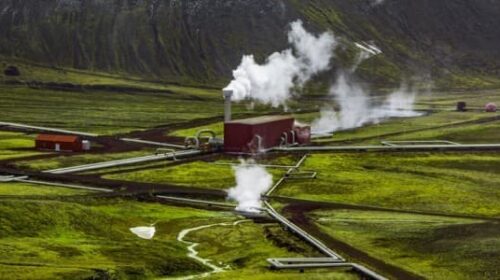The most cutting-edge approach for saving the planet from climate disaster doesn’t sound like it’s ripped out of the pages of science fiction. In fact, it doesn’t even sound like it’s ripped from the headlines. Far from new but nonetheless noteworthy, the ancient energy technology of using heat from the Earth’s core is finally ready for its close-up. While geothermal energy is already used around the world in relatively small-scale operations, scientists are working on scaling what could potentially be a clean, abundant, and cost-effective form of energy production suitable for almost anywhere on the planet.
Currently, the United States is the largest producer of geothermal energy in the world. This says a lot more about how little geothermal energy is produced worldwide, considering that geothermal accounts for just .4 percent of the United States’ total electricity generation, and only 2 percent of renewables. Only seven states have geothermal energy plants, producing a total of about 16 billion kilowatthours (or 16,238,000 megawatthours) all together. This is, in large part, because until now geothermal energy production has only occurred where it is easy and obvious to build a plant, such as in places where there are naturally occurring geysers and hot springs.
But geothermal energy is everywhere, if you’re willing and able to dig deep enough. Currently, scientists are working on developing ‘enhanced geothermal systems’ capable of tapping into this heat emanating from deep in the Earth even in areas where this heat doesn’t come close to the surface. According to recent reporting from Esquire, this technology will “allow us to exploit the energy underfoot across the country, all with a carbon impact that is vanishingly small compared to most sources we depend on now.” Drilling wells deep into the Earth to pump out hot water can be used to produce energy in a number of ways, before injecting that water back into the ground.
But we don’t need to wait for the commercialized rollout of enhanced geothermal systems to tap into geothermal energy in other important applications. In fact, you can get a major tax break for jumping on the bandwagon now. The Biden administration’s landmark Inflation Reduction Act (which is really a slimmed down version of the Build Back Better Act) has earmarked $500 million in tax breaks for U.S. residents who install heat pumps for their house. These pumps work by digging just 10 feet under the surface of the Earth – under your driveway or in your backyard – where the temperature of the soil is essentially constant year-round and can be used to heat or cool air, providing a highly efficient, low-emissions component of your home’s cooling and heating system.
One of the crucial benefits of geothermal power is that, unlike the leading renewable resources, it’s not variable. Solar power production varies according to the time of day, the time of year, and the weather. Wind power production depends on atmospheric variables far outside of human control. The Earth, on the other hand, is cranking out heat constantly and at a pretty stable temperature, meaning that geothermal offers an extremely stable and dependable energy source which will not require any of the costly energy storage workarounds or complex smart grids that solar and wind power will increasingly require. It’s what’s known as a “baseload power.” And a scalable, commercialized zero-emissions baseload power would be a game changer.
That’s not all that geothermal has going for it. In addition to being a baseload power, geothermal energy is also renewable, domestically available, clean, and it has a small footprint. According to a fact sheet on geothermal energy from the United States Office of Energy Efficiency and Renewable Energy, geothermal plants are particularly compact, requiring less land per gigawatt-hour (404 m2) than comparable-capacity coal (3,642 m2), wind (1,335 m2), and solar photovoltaic (PV) power stations (3,237 m2). This is also of enormous importance in the green energy transition, as large-scale solar and wind farms run up against potentially insurmountable challenges in securing enough real estate.
Geothermal seems to avoid every major challenge faced by prevailing green energy technologies. Making enhanced geothermal energy systems cost-effective and scalable won’t be a silver bullet solution to the world’s energy problems – but it’s pretty damn good.






